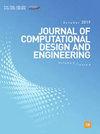HBWO-JS:水母搜索增强混合白鲸优化算法的工程应用
IF 6.1
2区 工程技术
Q1 COMPUTER SCIENCE, INTERDISCIPLINARY APPLICATIONS
引用次数: 1
摘要
白鲸优化算法(BWO)是近年来提出的一种种群智能算法。受白鲸种群的游泳、觅食和鲸鱼坠落行为的启发,与其他最先进的算法相比,它显示出良好的竞争性能。然而,在高维复杂应用中,原有的BWO算法面临着探索开发不平衡、迭代过早停滞、收敛精度低等挑战。针对这些挑战,本文开发了一种基于水母搜索优化器(HBWO-JS)的混合白鲸优化算法,该算法将垂直交叉算子和高斯变分策略与水母搜索(JS)融合优化器相结合,用于解决全局优化问题。首先,将BWO算法与JS优化器融合,通过多阶段探索和协同开发,改善BWO在开发阶段容易陷入局部最优解和收敛精度低的问题。然后,引入垂直交叉算子,通过正则化搜索智能体的两个随机维的上界和下界,解决了搜索开发过程不平衡的问题,进一步提高了整体优化能力。此外,引入的高斯变分策略迫使智能体探索最小邻域,延长了整个迭代搜索过程,从而缓解了算法过早停滞的问题。最后,通过在CEC2019和CEC2020测试套件上分别与基本BWO和八种最先进的算法进行比较,详细验证了所提HBWO-JS的优越性。同时,从10-dim、30-dim、50-dim三个维度对HBWO-JS的可扩展性进行了评价,结果表明该算法在维度可扩展性方面具有稳定的性能。此外,三个实际工程设计和两个桁架拓扑优化问题证明了HBWO-JS的实用性。优化结果表明,HBWO-JS具有较强的竞争力和广阔的应用前景。本文章由计算机程序翻译,如有差异,请以英文原文为准。
HBWO-JS: jellyfish search boosted hybrid beluga whale optimization algorithm for engineering applications
Beluga whale optimization (BWO) algorithm is a recently proposed population intelligence algorithm. Inspired by the swimming, foraging and whale falling behaviors of beluga whale populations, it shows good competitive performance compared to other state-of-the-art algorithms. However, the original BWO faces the challenges of unbalanced exploration and exploitation, premature stagnation of iterations, and low convergence accuracy in high-dimensional complex applications. Aiming at these challenges, a hybrid beluga whale optimization based on the jellyfish search optimizer (HBWO-JS), which combines the vertical crossover operator and Gaussian variation strategy with a fusion of jellyfish search (JS) optimizer, is developed for solving global optimization in this paper. First, the BWO algorithm is fused with the JS optimizer to improve the problem that BWO tends to fall into the best local solution and low convergence accuracy in the exploitation stage through multi-stage exploration and collaborative exploitation. Then, the introduced vertical cross operator solves the problem of unbalanced exploration and exploitation processes by normalizing the upper and lower bounds of two stochastic dimensions of the search agent, thus further improving the overall optimization capability. In addition, the introduced Gaussian variation strategy forces the agent to explore the minimum neighborhood, extending the entire iterative search process and thus alleviating the problem of premature stagnation of the algorithm. Finally, the superiority of the proposed HBWO-JS is verified in detail by comparing it with basic BWO and eight state-of-the-art algorithms on the CEC2019 and CEC2020 test suites, respectively. Also, the scalability of HBWO-JS is evaluated in three dimensions (10-dim, 30-dim, 50-dim), and the results show the stable performance of the proposed algorithm in terms of dimensional scalability. In addition, three practical engineering designs and two Truss topology optimization problems demonstrate the practicality of HBWO-JS. The optimization results show that HBWO-JS has a strong competitive ability and broad application prospects.
求助全文
通过发布文献求助,成功后即可免费获取论文全文。
去求助
来源期刊

Journal of Computational Design and Engineering
Computer Science-Human-Computer Interaction
CiteScore
7.70
自引率
20.40%
发文量
125
期刊介绍:
Journal of Computational Design and Engineering is an international journal that aims to provide academia and industry with a venue for rapid publication of research papers reporting innovative computational methods and applications to achieve a major breakthrough, practical improvements, and bold new research directions within a wide range of design and engineering:
• Theory and its progress in computational advancement for design and engineering
• Development of computational framework to support large scale design and engineering
• Interaction issues among human, designed artifacts, and systems
• Knowledge-intensive technologies for intelligent and sustainable systems
• Emerging technology and convergence of technology fields presented with convincing design examples
• Educational issues for academia, practitioners, and future generation
• Proposal on new research directions as well as survey and retrospectives on mature field.
 求助内容:
求助内容: 应助结果提醒方式:
应助结果提醒方式:


